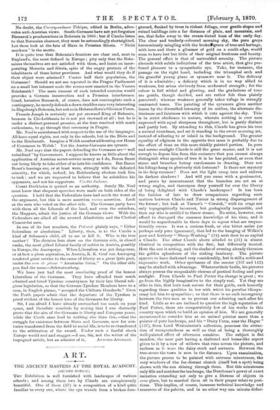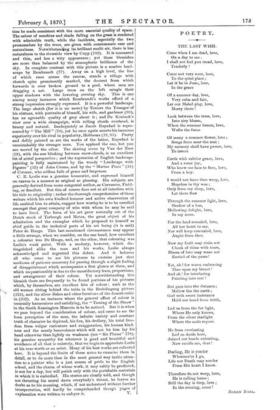ART.
THE ANCIENT MASTERS AT THE ROYAL ACADEMY.
(SECOND NOTICE.)
THE Exhibition is well furnished with landscapes of various schools ; and among them two by Claude are conspicuously beautiful. One of them (37) is a composition of a kind quite familiar to every one, where the eye travels from a broken fore-
ground, flanked by trees in richest foliage, over gentle slopes and ruined buildings into a far distance of plain, and mountain, and sea, that fades away in the cream-tinted hues of the early day. The clear and tenderly-coloured morning sky, the pure greys harmoniously mingling with the brokethreen of tree and herbage, with here and there a glimmer of gold on a sunlit edge, would seem to have lost but little of their original freshness and beauty. The general effect is that of untroubled serenity. The picture abounds with subtle indications of the true artist, that give pro- found pleasure to a sympathetic eye. Take, for instance, the passage on the right hand, including the triumphal arch and the graceful young plane or sycamore near it. The delicacy of it is admirable ; a delicacy which is in no way allied to weakness, but arises obviously from moderated strength ; for the colour is full withal and glowing, and the gradations of tone are gentle, though decided, and are rather felt than plainly perceived ; whereas weakness generally takes refuge in strongly contrasted tones. The painting of the sycamore gives another lesson by the diversified intensity of its outline, the alternate dis- tinctness and faintness with which it cuts against the sky. This is in strict obedience to nature, wherein nothing is ever seen expressed with equal sharpness throughout, but is partly distinct and partly lost. By attending to this, Claude has given his tree a natural roundness, and set it standing in the sweet morning air, instead of adhering to or inlaid in the background. The greater equality of edginess in the opposite tree mass is probably due to the effect of time on this more thickly painted portion. In pure and serene sunlight Claude is still the great master, and it is not enough to depose him from this eminence that you cannot always distinguish what species of tree it is he has painted, or even that stems and branches betray carelessness in drawing. Does not his foliage hang in gloriously rich festoons? Is there not mystery in its deep recesses? Does not the light creep into and enliven its darkest shadows ? And will you come with a goniometer, and prove by measurement that the branches are set on at wrong angles, and thereupon deny yourself for ever the liberty of being delighted with Claude's landscapes ? It has been the fashion of late to draw comparisons regarding such matters between Claude and Turner in strong disparagement of the former; but look at Turner's " Coruisk," with its crags not only topographically incorrect, but geologically impossible, and then say who is entitled to throw stones. No artist, however, can afford to disregard the common knowledge of his time, and it would be unpardonable in these days to repeat what are unques- tionably errors. It was a curious freak, or else bitter satire (or perhaps only pure ignorance), that led to the hanging of Wilkie's poor and leathery " Sheep-Washing " (34) next door to so capital a Claude. The other Claude above alluded to (21) is almost identical in composition with the first, but differently treated. Here the sun is setting, and the shades of evening already threaten the golden splendours of the sinking luminary. The picture appears to have darkened very considerably, but is still a noble and impressive work. Other specimens of the master (107 and 142) may be studied with advantage. Whatever their faults, his pictures always possess the unspeakable charms of poetical feeling and pure sunlight. From Claude to Paul Potter the change is great ; we go from the highly imaginative to the simply real. Yet they are alike in this, that both took nature for their guide, each honestly regarding those qualities in her with which his peculiar idiosyn- crasy led him to sympathize ; so that there is no such incongruity between the two men as to prevent our admiring each after his kind. Little as we are inclined to question the high reputation of Paul Potter, there are comparatively few of his works in this country upon which to build an opinion of him. We are generally accustomed to consider him as an animal painter more than a painter of pure landscape, and his "Dairy Farm, near the Hague" (127), from Lord Westminster's collection, possesses the attrac- tion of unexpectedness as well as that of being a thoroughly well-painted effect of afternoon sunshine. The subject is flat meadow, the near part having a sheltered and home-like aspect given to it by a row of willows that runs across the picture, and incloses as it were the dairy stock and servants. Between the tree-stems the town is seen in the distance. Upon examination, the picture proves to be painted with extreme minuteness, the very windows of the far-distant church (itself but a spot) being shown with the sun shining through them. But this minuteness only fills and enriches the landscape, the Dutchman's power of exact imitation extending not only to give a likeness of objects in some place, but to marshal them all in their proper relative posi- tions. This implies, of course, immense technical knowledge and resources of the palette, and in no other way can minute defied- tion be made consistent with the more essential quality of space. The colour of sunshine and shade falling on the grass is rendered with admirable truth, while the incidents, especially the two promenaders by the trees, are given with consummate ease and naturalness. Notwithstanding its brilliant sunlit air, there is less
naturalness in the riverside view by Cuyp (102). It.is mannered
and thin, and has a wiry appearance ; yet these blemishes are more than balanced by the atmospheric brilliance of the sky. In complete contrast with this picture is a sombre land- scape by Rembrandt (77). Away on a high level, the line of which runs across the canvas, stands a village with church spire prominently marked, the descent from which forwards is over broken ground to a pool, where men are dragging a net. Lane tress on the left mingle their
upper shadows with the lowering evening sky. This is one among many instances which Rembrandt's works afford of a strong impression strongly expressed. It is a powerful landscape. The large sketch (for it is no more) by Tethers the Younger of his chateau, with portraits of himself, his wife, and gardener (90), has an agreeable quality of grey about it ; and De Kiininck's view over a wide champaign, with rolling clouds overhead, is breezy and natural. Inadequately as Jacob Ruysdael is repre- sented by "The Mill" (70), yet he once again asserts his immense superiority over his rival in popularity, Hobberna (19, 95). Pretty and deftly painted as are the works of the latter, Ruysdael is unmistakably the stronger man. You applaud the one, but you are moved by the other. The skating scene by Van der Neer (18), with the sun blinking between snow-clouds, is an excellent bit of aerial perspective ; and the reputation of English landscape painting is fully maintained by the woody "Landscape with Figures" (32) of John Crome, and by the "Marine Piece" (24) of Cotman, who seldom fails of grace and largeness.
C. It. Leslie was a genuine humourist, and expressed himself on canvas in a manner as original as pleasing. His subjects are generally derived from some congenial author, as Cervantes, Field- ing, or Smollett. But this of course does not at all interfere with his title to originality ; rather the thorough comprehension of those writers which his own kindred humour and active observation of life enabled him to attain, suggest how worthy be is to be enrolled amongst that great company of wits with whom he may be said to have lived. The form of his art grew naturally out of the Dutch stock of Terburgh and Metzu, the great object of his admiration and the exemplar which he proposed to himself as chief guide in the technical parts of his art being (it is said) Peter de Hooge. This last-mentioned circumstance may appear a little strange, when we consider, on the one hand, how excellent a colourist was De Hooge, and, on the other, that colouring was Leslie's weak point. 1Vith a modesty, however, which dis- tinguished alike the man and his works, Leslie always acknowledged and regretted this defect. And it behoves all who come to see his pictures to exercise just that modicum of patience necessary for passing through a slight feeling of disappointment which accompanies a first glance at them, and which unquestionably is due to the unsatifactory hues, proportions, and arrangement of their colour. Yet notwithstanding this blemish there are frequently to be found portions of his pictures which, by themselves, are excellent bits of colour ; such as the old woman sitting behind the table in the Brobdingnag picture (222), and the silver dishes and other furniture of the dessert-table in (202). As an instance where the general effect of colour is unusually harmonious and satisfying, the "Taming of the Shrew" in the South Kensington Museum is to be noticed. But it is when we pass beyond the consideration of colour, and come to see the keen perception of the man, the infinite variety and constant truth of character he depicted, his fun, his drollery, his total free- dom from vulgar caricature and exaggeration, his human kind- ness and the manly benevolence which will not let him lay his hand otherwise than lightly on weakness (see "Sir Plume" 178), his genuine sympathy for whatever is good and beautiful and avoidance of all that is unlovely, that we begin to appreciate Leslie at his true worth as an artist. Many of his best works are collected here. It is beyond the limits of these notes to examine them in detail, Or to do more than in the most general way invite atten- tion to a painter who is a just source of pride to the English school, and the charm of whose work, it may safely be predicted, is not for a day, but will perish only with the perishable materials in which it is embodied. His stories are clearly told, and though not thrusting his moral down everybody's throat, he leaves no doubt as to his meaning, which, if not understood without further interpretation, will hardly be comprehended though pages of



































 Previous page
Previous page